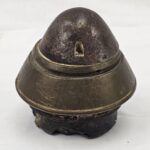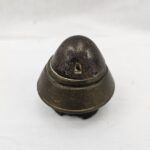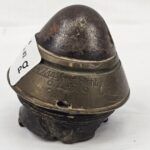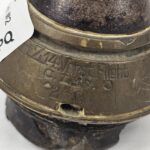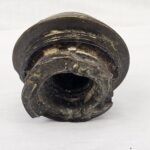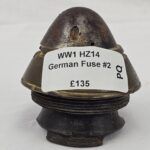~ WW1 HZ14 German Fuze #2 ~
The HZ14 (Hertz-Zünder 1914) fuze was a significant development in artillery munitions used by the German Army during World War I. It represented a technological advancement in how shells were detonated, directly influencing the effectiveness and lethality of artillery fire.
Here’s a detailed look into its history and functionality:
Development and Features
- Introduction: The HZ14 fuze was introduced in 1914, at the beginning of World War I, as part of Germany’s efforts to improve the efficiency and impact of their artillery.
- Design Purpose: It was designed to ensure that shells exploded upon impact or after a very short delay, maximizing the damage caused by the shrapnel or blast effect.
- Technology: The fuze utilized a mechanical impact-detonating mechanism, which was a significant improvement over earlier time-fuse designs that detonated at a preset time after firing.
Impact on Warfare
- Effectiveness: The introduction of the HZ14 and similar impact-detonating fuzes marked a significant shift in artillery tactics. These fuzes allowed for more precise targeting of enemy trenches, bunkers, and fortifications.
- Airburst Capability: Although primarily an impact fuze, the technology laid the groundwork for the development of more advanced fuzes, including those capable of airburst detonations, which were designed to explode above the ground for maximum effect against exposed troops.
Legacy
- Innovation in Munitions: The HZ14 fuze is an example of the rapid technological innovations in munitions that characterized World War I. The war saw significant advancements in weaponry, including firearms, artillery, and chemical weapons.
- Influence on Subsequent Designs: The principles and mechanisms developed for the HZ14 fuze influenced later designs of artillery fuzes, both in Germany and internationally. Its impact is seen in the continued evolution of munitions technology throughout the 20th century.
Challenges and Limitations
- Technical Challenges: Like all new technologies, the HZ14 fuze faced challenges, including reliability issues under certain conditions. However, ongoing improvements and adaptations helped mitigate these issues over time.
- Humanitarian Concerns: The increased lethality of artillery munitions, enabled by technologies like the HZ14 fuze, raised significant humanitarian concerns, especially regarding civilian casualties and the long-term impact on combatants.
The HZ14 fuze represents an important chapter in the history of military technology, highlighting the continuous drive for improvement in weapons systems and the profound impact of these advancements on the conduct and outcome of warfare.









